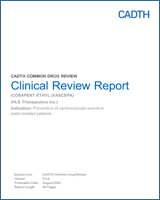Clinician Input
All CADTH review teams include at least one clinical specialist with expertise regarding the diagnosis and management of the condition for which the drug is indicated. Clinical experts are a critical part of the review team and are involved in all phases of the review process (e.g., providing guidance on the development of the review protocol, assisting in the critical appraisal of clinical evidence, interpreting the clinical relevance of the results, and providing guidance on the potential place in therapy). The following input was provided by clinical specialists with expertise in the diagnosis and management of CVD and dyslipidemia.
Description of the Current Treatment Paradigm for the Disease
Patients with established CVD (defined as the secondary prevention group) and patients with diabetes and one or more CV risk factor(s) (the primary prevention or at high risk group) can remain at high risk for a MACE due to persistent high levels of TGs, even after treatment with statins. Studies of added therapies to reduce these persistent levels of TGs, such as fibrates or niacin, have demonstrated little to no effect for decreasing the risk of CV events. Fish oil supplements containing omega-3 fatty acids EPA and DHA have been tested as well, with no difference in the risk reduction for further MACE. This group of patients with residual risk despite optimized statin therapy is an important subgroup of patients with a need for treatments to reduce the risk of CV events.
Treatment Goals
The main goal of treatment in this specific group of patients is the achievement of a reduced risk of CV events, including CV death, MI, stroke, and need for urgent revascularization.
Unmet Needs
Currently, available treatments are not meeting the goals and needs of patients who have persistent elevated levels of TGs and low HDL-c. These patients remain at higher risk of CV events when compared to those whose values have been normalized after therapy and lifestyle modifications. Treatments are needed to reduce high TG levels in this group of patients with residual risk. Furthermore, current research has not identified definite subgroups in whom an intervention will have increased efficacy.
Place in Therapy
Although the exact mechanism of action of icosapent ethyl is not yet fully understood, previous studies have shown a reduction in TG levels, probably involving complex anti-inflammatory, antithrombotic, and TG metabolism effects. Icosapent ethyl could be used when TG levels remain elevated despite stable use of statin therapy (i.e., for more than four weeks). Currently, no other medication has clear and consistent evidence for reducing elevated TG levels in patients with established arteriosclerotic CVD and in patients with diabetes and other high-risk features. Although icosapent ethyl may reduce the use of niacin and fibrates, as well as omega-3 fatty acid supplements (non-prescription), its main use will be as a complementary intervention to treat and prevent atherosclerosis in this group of patients. It is not expected to be used as first-line therapy and is therefore unlikely to cause a clinical paradigm shift.
Patient Population
Patients with established CVD or with diabetes and with elevated levels of TGs (i.e., those meeting the inclusion criteria from the included studies and the indication for this review) will be the target population for treatment with icosapent ethyl in clinical settings. Only one study has been able to confirm these conditions,25 and, as expected, we do not know the effect on those patients outside the inclusion criteria.
Patients to be treated with icosapent ethyl would have to be receiving treatment — and on stable dosages — with statins that is maximally tolerated, as well as receiving treatment with other guideline-recommended therapies. These patients would ideally be identified and assessed by primary care physicians or specialists in cardiology or endocrinology who have full access to the patients’ family and medical history, with information about their lipid profile and other pertinent tests (e.g., to confirm the diagnosis of diabetes), as well as detection of other risk factors. Within these patients, no specific subgroups of patients have been identified so far in whom icosapent ethyl would have greater efficacy.
Assessing Response to Treatment
The benefits from the intervention are expected to have clear and objective outcomes, as stated in this review and the included trials. These outcomes are a reduction in CV death, MACEs (MI and stroke), and need for revascularization. Measuring response to treatment in individual patients might be difficult, as the most appropriate way would be by measuring TG levels; however, there has been no relationship found between levels of TGs and clinical response according to the currently available evidence.
Discontinuing Treatment
The intervention might be discontinued if intolerance develops (adverse effects). However, in the current literature, there are no specific data on harms that would drive this decision, so the decision to discontinue would most likely be made based on purely empirical and clinical observations and the physician’s judgment.
Prescribing Conditions
The appropriate and most likely setting for the prescription of icosapent ethyl will be primary care (outpatient clinics and family physicians), followed by specialty and sub-specialty programs, supporting primary care. Guideline adherence and implementation will play an important role in attaining the maximum possible and appropriate use of the drug.

